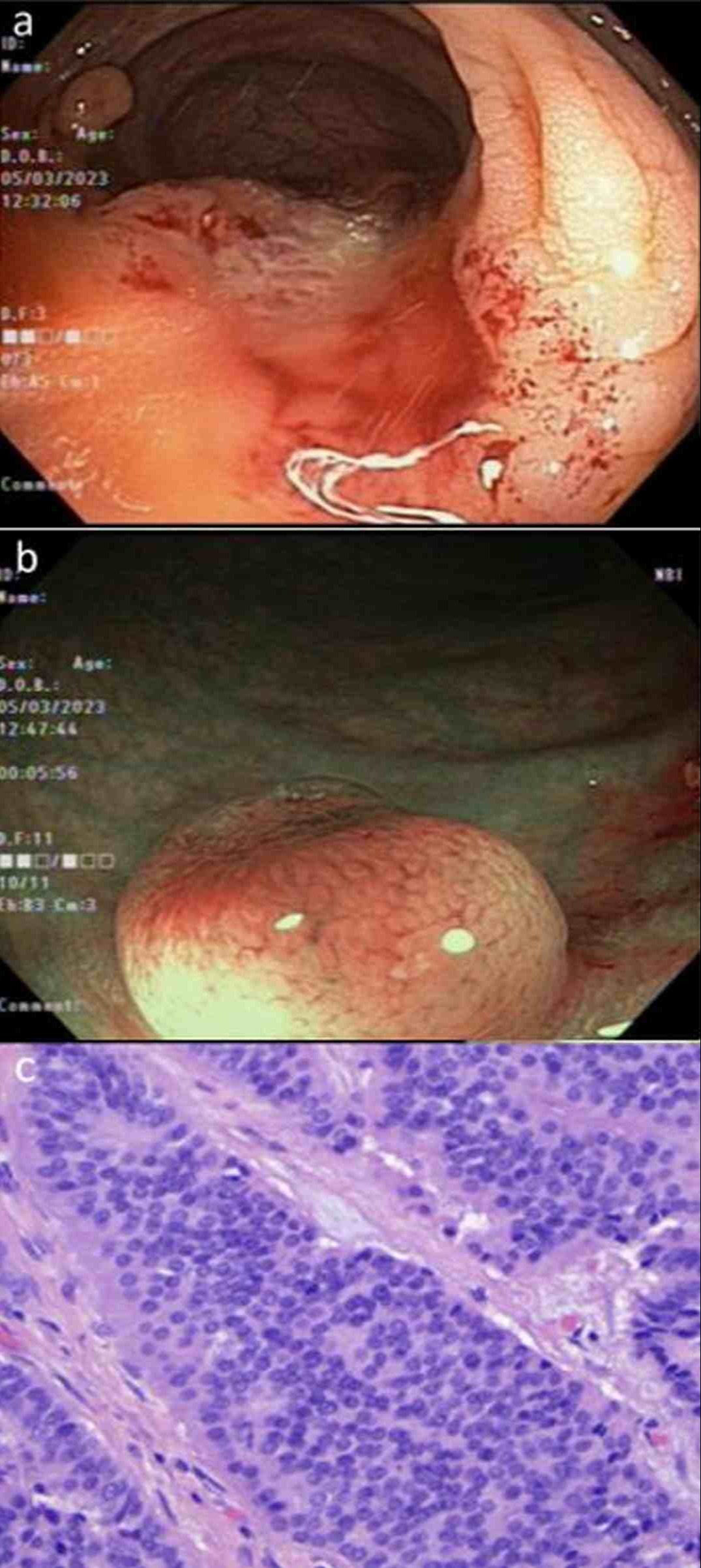Sunday Poster Session
Category: Colon
P0214 - Rectal Adenocarcinoma Mimic: A Rare Case of Metastatic Rectal Neuroendocrine Tumor
Sunday, October 22, 2023
3:30 PM - 7:00 PM PT
Location: Exhibit Hall

Kwabena O. Adu-Gyamfi, MD
Medical College of Georgia at Augusta University
Augusta, GA
Presenting Author(s)
Kwabena O. Adu-Gyamfi, MD1, Kwabena O. Asafo-Agyei, MD2, Dariush Shahsavari, MD3, Trina Biswas, BSc3, Amanda Barrett, MD4, Ahmad Alkaddour, MD5
1Medical College of Georgia at Augusta University, Augusta, GA; 2Christus Highland Hospital, Shreveport, LA; 3Medical College of Georgia, Augusta, GA; 4Medical College of Georgia at Augusta University, Augusta, GA; 5Augusta University Medical Center, Augusta, GA
Introduction: Neuroendocrine neoplasms are a group of epithelial tumors ranging from indolent well-differentiated neuroendocrine tumors (NET) to very aggressive poorly-differentiated neuroendocrine carcinoma (NEC). Rectal NET are usually diagnosed incidentally as small asymptomatic lesions on screening colonoscopy most commonly in the 50 to 60-year age group. We present an unusual case of a young woman with synchronous and metastatic rectal neuroendocrine tumors closely mimicking rectal adenocarcinoma.
Case Description/Methods: A 32-year-old African American woman with history of hypertension and chronic constipation was noted to have elevated liver chemistries on routine outpatient testing. Right upper quadrant ultrasound revealed multiple large liver lesions. Computed tomography (CT) scan of the abdomen & pelvis noted a rectal mass with numerous liver lesions concerning for metastatic rectal adenocarcinoma. Colonoscopy revealed a large firm ulcerated rectal mass which was biopsied (Fig 1a) as well as an 8 mm rectal polyp just proximal to it (Fig 1b) which was resected by snare cautery. Histopathology of the resected polyp (Fig 1c) and rectal mass biopsies both returned as well differentiated neuroendocrine tumors grade 1 and grade 2 respectively. Immunohistochemical staining for synaptophysin and chromogranin was positive. Liver biopsies later also confirmed metastatic well differentiated neuroendocrine tumor. After further oncology evaluation, long-acting octreotide acetate was initiated, and she continues close follow up.
Discussion: Rectal neuroendocrine tumors (NET) are rare with an incidence of 0.17%. Incidence has increased 10-fold over the past 3 decades, partly from increased screening colonoscopies. Features include firm, non-mobile, polypoid or round lesions with a reddish/yellow hue of overlying mucosa which may be smooth or ulcerated. This case of synchronous and metastatic rectal NET mimicking rectal adenocarcinoma is rare. Larger NET ( >20mm) have a 60-80% risk of distant metastasis and complete surgical resection with total mesorectal excision should be considered for all cases. For unresectable or metastatic disease, long-acting somatostatin analogs have been shown to slow tumor growth and control symptoms related to hormone secretion. Increased provider awareness of the features and optimal management of rectal NET will facilitate timely intervention to improve clinical outcomes.

Disclosures:
Kwabena O. Adu-Gyamfi, MD1, Kwabena O. Asafo-Agyei, MD2, Dariush Shahsavari, MD3, Trina Biswas, BSc3, Amanda Barrett, MD4, Ahmad Alkaddour, MD5. P0214 - Rectal Adenocarcinoma Mimic: A Rare Case of Metastatic Rectal Neuroendocrine Tumor, ACG 2023 Annual Scientific Meeting Abstracts. Vancouver, BC, Canada: American College of Gastroenterology.
1Medical College of Georgia at Augusta University, Augusta, GA; 2Christus Highland Hospital, Shreveport, LA; 3Medical College of Georgia, Augusta, GA; 4Medical College of Georgia at Augusta University, Augusta, GA; 5Augusta University Medical Center, Augusta, GA
Introduction: Neuroendocrine neoplasms are a group of epithelial tumors ranging from indolent well-differentiated neuroendocrine tumors (NET) to very aggressive poorly-differentiated neuroendocrine carcinoma (NEC). Rectal NET are usually diagnosed incidentally as small asymptomatic lesions on screening colonoscopy most commonly in the 50 to 60-year age group. We present an unusual case of a young woman with synchronous and metastatic rectal neuroendocrine tumors closely mimicking rectal adenocarcinoma.
Case Description/Methods: A 32-year-old African American woman with history of hypertension and chronic constipation was noted to have elevated liver chemistries on routine outpatient testing. Right upper quadrant ultrasound revealed multiple large liver lesions. Computed tomography (CT) scan of the abdomen & pelvis noted a rectal mass with numerous liver lesions concerning for metastatic rectal adenocarcinoma. Colonoscopy revealed a large firm ulcerated rectal mass which was biopsied (Fig 1a) as well as an 8 mm rectal polyp just proximal to it (Fig 1b) which was resected by snare cautery. Histopathology of the resected polyp (Fig 1c) and rectal mass biopsies both returned as well differentiated neuroendocrine tumors grade 1 and grade 2 respectively. Immunohistochemical staining for synaptophysin and chromogranin was positive. Liver biopsies later also confirmed metastatic well differentiated neuroendocrine tumor. After further oncology evaluation, long-acting octreotide acetate was initiated, and she continues close follow up.
Discussion: Rectal neuroendocrine tumors (NET) are rare with an incidence of 0.17%. Incidence has increased 10-fold over the past 3 decades, partly from increased screening colonoscopies. Features include firm, non-mobile, polypoid or round lesions with a reddish/yellow hue of overlying mucosa which may be smooth or ulcerated. This case of synchronous and metastatic rectal NET mimicking rectal adenocarcinoma is rare. Larger NET ( >20mm) have a 60-80% risk of distant metastasis and complete surgical resection with total mesorectal excision should be considered for all cases. For unresectable or metastatic disease, long-acting somatostatin analogs have been shown to slow tumor growth and control symptoms related to hormone secretion. Increased provider awareness of the features and optimal management of rectal NET will facilitate timely intervention to improve clinical outcomes.

Figure:
Fig 1a. Endoscopic picture showing ulcerated rectal mass; metastatic NET Grade 2 with rectal polyp in the background. Fig 1b. Endoscopic picture in Narrow Band Imaging (NBI) showing rectal polyp; NET Grade 1. Fig 1c. Histology slide of rectal polyp 400x H&E showing uniform round nuclei with finely stippled “salt and pepper” chromatin consistent with NET.
Fig 1a. Endoscopic picture showing ulcerated rectal mass; metastatic NET Grade 2 with rectal polyp in the background. Fig 1b. Endoscopic picture in Narrow Band Imaging (NBI) showing rectal polyp; NET Grade 1. Fig 1c. Histology slide of rectal polyp 400x H&E showing uniform round nuclei with finely stippled “salt and pepper” chromatin consistent with NET.
Disclosures:
Kwabena Adu-Gyamfi indicated no relevant financial relationships.
Kwabena Asafo-Agyei indicated no relevant financial relationships.
Dariush Shahsavari indicated no relevant financial relationships.
Trina Biswas indicated no relevant financial relationships.
Amanda Barrett indicated no relevant financial relationships.
Ahmad Alkaddour indicated no relevant financial relationships.
Kwabena O. Adu-Gyamfi, MD1, Kwabena O. Asafo-Agyei, MD2, Dariush Shahsavari, MD3, Trina Biswas, BSc3, Amanda Barrett, MD4, Ahmad Alkaddour, MD5. P0214 - Rectal Adenocarcinoma Mimic: A Rare Case of Metastatic Rectal Neuroendocrine Tumor, ACG 2023 Annual Scientific Meeting Abstracts. Vancouver, BC, Canada: American College of Gastroenterology.
